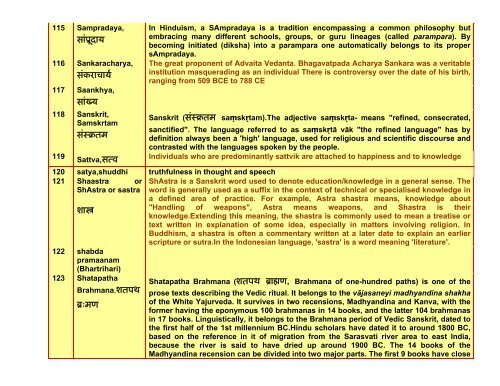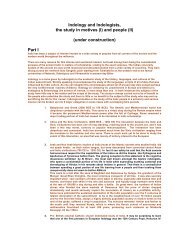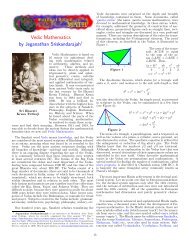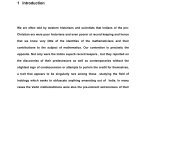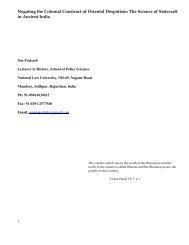The Dhaarmik Traditions - Indic Studies Foundation
The Dhaarmik Traditions - Indic Studies Foundation
The Dhaarmik Traditions - Indic Studies Foundation
You also want an ePaper? Increase the reach of your titles
YUMPU automatically turns print PDFs into web optimized ePapers that Google loves.
115 Sampradaya,<br />
सांूूदाय<br />
116 Sankaracharya,<br />
संकराचायर्<br />
117 Saankhya,<br />
सांख्य<br />
118 Sanskrit,<br />
Samskrtam<br />
संःबतम<br />
119<br />
Sattva,सत्व<br />
In Hinduism, a SAmpradaya is a tradition encompassing a common philosophy but<br />
embracing many different schools, groups, or guru lineages (called parampara). By<br />
becoming initiated (diksha) into a parampara one automatically belongs to its proper<br />
sAmpradaya.<br />
<strong>The</strong> great proponent of Advaita Vedanta. Bhagavatpada Acharya Sankara was a veritable<br />
institution masquerading as an individual <strong>The</strong>re is controversy over the date of his birth,<br />
ranging from 509 BCE to 788 CE<br />
Sanskrit (संःबतम saṃskṛtam).<strong>The</strong> adjective saṃskṛta- means "refined, consecrated,<br />
sanctified". <strong>The</strong> language referred to as saṃskṛtā vāk "the refined language" has by<br />
definition always been a 'high' language, used for religious and scientific discourse and<br />
contrasted with the languages spoken by the people.<br />
Individuals who are predominantly sattvik are attached to happiness and to knowledge<br />
120 satya,shuddhi truthfulness in thought and speech<br />
121 Shaastra or<br />
ShAstra or sastra<br />
शास्तर्<br />
122 shabda<br />
pramaanam<br />
(Bhartrihari)<br />
123 Shatapatha<br />
Brahmana,शतपथ<br />
ॄःमण<br />
ShAstra is a Sanskrit word used to denote education/knowledge in a general sense. <strong>The</strong><br />
word is generally used as a suffix in the context of technical or specialised knowledge in<br />
a defined area of practice. For example, Astra shastra means, knowledge about<br />
"Handling of weapons", Astra means weapons, and Shastra is their<br />
knowledge.Extending this meaning, the shastra is commonly used to mean a treatise or<br />
text written in explanation of some idea, especially in matters involving religion. In<br />
Buddhism, a shastra is often a commentary written at a later date to explain an earlier<br />
scripture or sutra.In the Indonesian language, 'sastra' is a word meaning 'literature'.<br />
Shatapatha Brahmana (शतपथ ॄाह्मण, Brahmana of one-hundred paths) is one of the<br />
prose texts describing the Vedic ritual. It belongs to the vājasaneyi madhyandina shakha<br />
of the White Yajurveda. It survives in two recensions, Madhyandina and Kanva, with the<br />
former having the eponymous 100 brahmanas in 14 books, and the latter 104 brahmanas<br />
in 17 books. Linguistically, it belongs to the Brahmana period of Vedic Sanskrit, dated to<br />
the first half of the 1st millennium BC.Hindu scholars have dated it to around 1800 BC,<br />
based on the reference in it of migration from the Sarasvati river area to east India,<br />
because the river is said to have dried up around 1900 BC. <strong>The</strong> 14 books of the<br />
Madhyandina recension can be divided into two major parts. <strong>The</strong> first 9 books have close


